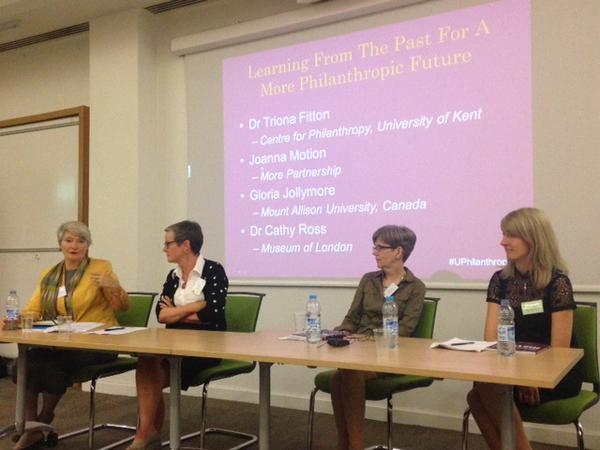
Opinion
Greening our own grass
by Joanna Motion - 30 June 2015
A personal reflection from More Partnership’s Joanna Motion
A pilgrimage to Canterbury on a sunny summer’s day for the Understanding Philanthropy Conference, one of the 50 Beacon projects with which the University of Kent is marking its 50th birthday. Lovely to be back on campus. School children eating packed lunches on the grass with the view down to the Cathedral; lots of building work in train. Very buzzy.
Inside, the University’s Centre for Philanthropy launched Hidden History: Philanthropy at the University of Kent. Congratulations to Triona Fitton, Cathy Ross and Beth Breeze on both the book and a stimulating conference. The Kent researchers have unearthed some gems from the archives – things I wish I’d known 20 years ago when I was Kent’s second Director of Development.
Kent like Warwick, Sussex, York and the other siblings in the group of ’60s universities was required to demonstrate “ample evidence of strong local support” – including money – as a condition of getting university status. Their initial fundraising efforts, what we would now call a Campaign but was then an Appeal, brought in sums ranging from £600,000 (Kent) to £1.4m (UEA) to £2.75m (Warwick).
It’s eyebrow-raising to learn now that Kent’s founding Vice-Chancellor, Geoffrey Templeman, saw the need for the Appeal but airily thought that with the right leadership “the mechanics of the business will take care of themselves…” They didn’t, of course. It’s a long journey from the world of the Director of the 1960’s Appeal, the wonderfully named Sir Cyril Syers, KCMG, CVO, MA, to Kent’s Director of Development of today, Alison Coles, and from the mindset of the one-off Appeal to an embedded and ongoing commitment to fundraising and alumni relations.
It’s embarrassing to realise that, with the (infra dig?) business of the founding Appeal behind them, there followed a 15-20 year period when a collective amnesia descended on many of those ’60s universities: am I right in thinking that they all but lost the institutional memory of the contribution – even the names – of those founding donors and the community support they represented? And lost touch with a tradition of giving to UK universities that goes back eight centuries. Sigh.
So those universities had to overcome a kind of innocence among key players and to recover lost ground when they refocused on philanthropy in the 1980s. The progress since then is there for all to see: in Kent’s case, it is captured in Hidden History, demonstrated in the diggers going into action for the Wigoder Law Building (including space for Kent’s pro bono Law Clinic) and it underpins, I reckon, a stronger institutional confidence: the University has proved through 6- and 7-figure gifts that its ideas and competence are compelling enough to attract external support.
What of the obstacles of the future? A couple of strands of thinking in the Q&A at the Understanding Philanthropy conference trouble me. One is the worry that philanthropy can be seen to favour the successful; the “cumulative advantage” that we addressed in the Mythbusting section of The Pearce Report in 2012. It was pointed out from the floor that Kent’s endowment is a small fraction of (inevitably) Harvard’s and Oxford’s. Well, yes. But that’s hardly a reason for getting half-hearted about philanthropy. Kent’s fabulous (and already relentlessly-used) Colyer-Fergusson music performance building is hugely local, the product of an alignment of interest between the institution and donors, growing out of a focused case for support and nurtured through long relationships. When I look at the table of revenue from the founding Appeals of the ’60s universities and think about their philanthropic firepower 50 years on, my sense is that the great improver is the university where I worked in the early ’80s, UEA. Wherever you start from, good fundraising behaviour translates into gifts.
Another concern is the voice sometimes heard from within the mainstream charity sector that the acceleration in university fundraising is somehow at the cost of other good causes. “You’re appointing some very smart people to university development offices”, we heard at the conference. Well, again, yes. Hooray. There aren’t yet nearly enough of them (as the More Partnership/Richmond Associates 2014 report for HEFCE, An Emerging Profession, documented). But as we contemplate the arrival, for instance, of a vaccine for malaria, I can’t view the increasing professionalism of university fundraisers as anything but a good thing for the world…
One of the conclusions of An Emerging Profession was the value of greater exchange and collaboration between the various elements of the fundraising landscape. A report we can all learn from, educational fundraiser and high street charity alike, was also in the spotlight at the Kent conference: Fundraising for Unpopular Causes identifies the barriers faced by charities focusing on demanding topics, from migrants to mental health, and shows how they have built public support and investment. The grass may look greener the other side of the institutional or the sectoral fence. Our task is to use all our knowledge and intelligence to fertilise our own grass.
Happy birthday, Kent. Here’s to the next 50 productive (and philanthropic) years.